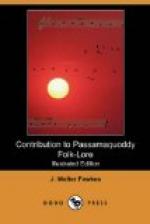A story of the old times.[7] Two men desired to find the origin of thunder. They set out and travelled north, and came to high mountains. These mountains drew back and forth, and then closed together very quickly. One of the men said to the other, “I will leap through the cleft when it opens, and if I am caught you can follow and try to find the origin of thunder.” The first one passed through the cleft before it closed, and the second one was caught. The one that went through saw, in a large plain below, a group of wigwams, and a number of Indians playing ball. After a little while these players said to each other, “It is time to go.” They went to their wigwams and put on wings, and took their bows and arrows and flew away over the mountains to the south. The old men said to the Indian, “What do you want? Who are you?” He told his mission, and they deliberated what to do. Finally they took him and put him in a mortar and pounded him up so that all his bones were broken. Then they took him out and gave him wings and a bow and arrows, and sent him away. They told him he must not go near the trees, for if he did he would go so fast that he could not stop, but would get caught in the crotch of a tree.
[Footnote 7: The Zuni folk-tales always begin with a similar introduction, which may be translated, “In the time of the ancients.” The Passamaquoddies often end a story by the words which, being translated, mean “this is the end.” The same occurs in other Indian stories.]
He could not get to his home because the bird Wochowsen blew so hard that he could make no progress against it. As the Thunder-Bird is an Indian, the lightning from him never strikes one of his kind.[8]
[Footnote 8: The wind (Wochowsen) is represented as resisting the Thunder-Bird. According to Chamberlain and Leland, “thunder beings are always trying to kill a big bird in the south.” It is said by the Passamaquoddies that Wochowsen is the great bird which overspreads all with his wings and darkens the sky. Often when he passes by, the glare of the bright sun is ample to blind them.]
This is the same bird one of whose wings Glooscap once cut when it had used too much force. There was for a long time, the story goes, no moving air, so that the sea became full of slime, and all the fish died. But Glooscap is said to have repaired the wing of Wochowsen, so that we now have wind alternating with calm.
BLACK CAT AND THE SABLE.
The translation of the following tale of Pogump, or Black Cat and the Sable, was given me by Mrs. W. Wallace Brown.[9] The original was told into the phonograph in Passamaquoddy by Peter Selmore, in the presence of Noel Josephs. A bark picture of Pookjinsquess leaving the island, representing the gulls, and Black Cat on the back of the Snail, was made by Josephs. A copy of this picture is given at the end of this paper.




